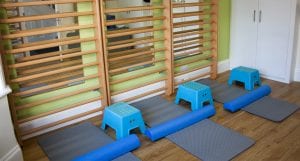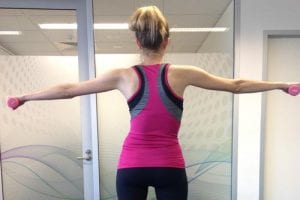Over the next few weeks, we’ll be posting about Scoliosis in the run up to our special events for Scoliosis awareness month, which begins in June. Last week, we looked at who is at risk from scoliosis, and how you might spot the early signs. Be sure to check out last week’s post here if you missed it.
This week, we look at how scoliosis can be treated and what the prognosis is.
Is Scoliosis easy to treat?
Once upon a time, in the not so distant past, it was believed that the only effective treatment for scoliosis was surgery. The medical establishment broadly took the view that scoliosis patients should be left and observed, with the hope that progression would stop on it own, but with the expectation of surgery down the line.
The good news is that today, scoliosis (especially when caught early) can certainly be treated, and unlike even 10 years ago, the prognosis is now very good in most cases.
The two main non-surgical treatment methodologies used currently are exercise-based approaches and bracing. Bracing is the most effective way to reduce a cobb angle (cobb angle is the measurement of scoliotic curve) and avoid surgery. In one recent study of 113 patients, the vast majority achieved an almost complete curve correction and only 4.9% of patients needed surgery.[i] Results vary by brace – but some studies have shown success rates with bracing as high as 100%.[ii]
Scoliosis specific exercise can be effective in treating smaller curves (generally below 20 degrees) where there is a lower risk of progression, but is probably best used in support of bracing, as a method to address muscular imbalances and postural problems which can often result from scoliosis.
Although the “wait and see” or “observation” approach to scoliosis management is now outdated, it is often still recommended by GP’s and is sadly still the favoured approach within the NHS. Unfortunately, the vast majority of scoliosis cases will progress, so it is better to seek advise from a scoliosis professional wherever possible.
Observation (Wait and see)
Observation is not a treatment for scoliosis, it is simply the act of watching and waiting – however, scoliosis almost never resolves without treatment.
Research has demonstrated that Juvenile scoliosis greater than 30 degrees increases rapidly and presents a 100% prognosis for surgery. Curves from 21 to 30 degrees are more difficult to predict but can frequently end up requiring surgery, or at least causing significant disability.[iii]
Because observation is not a treatment, it most often leads to the patient requiring surgery. By contrast, today, through modern bracing technology, it has been demonstrated that conservative treatment with a brace is highly effective in treating juvenile idiopathic scoliosis. In one recent study of 113 patients, the vast majority achieved a complete curve correction and only 4.9% of patients needed surgery.[iv]
Bracing
Scoliosis braces are the most effective non-surgical method for reducing cobb angle[v] There are many different kinds of scoliosis brace and many work slightly differently, however broadly speaking braces can be classified as active correction braces (which aim to reduce scoliosis by guiding the spine back to correct posture) and passive braces (which aim to prevent scoliosis from developing any further by holding the spine in its current position).
Results vary by brace – but some studies have shown success rates with bracing as high as 100%.[vi]
Scoliosis bracing in children and adolescents is recommended when Cobb angles over 20° are observed and there is a risk of progression as the child grows. For cobb angles under 20°, bracing might still be a preferred treatment option, since (unlike exercise) no conscious effort is necessary from the wearer.
Night-time braces are also an attractive option for single curves not exceeding 35 degrees in magnitude.[vii]
Schroth Therapy
Schroth therapy is a well-established and easy to use exercise methodology which some experts consider to be the best exercise-based approach for treating Idiopathic Scoliosis. [viii]
As an independent treatment, some studies have shown a reduction of cobb angle of 10-15 degrees over the course of a year[ix] – however Schroth therapy combines particularly well with bracing. When Schroth is combined with bracing superior results can often be achieved more quickly.[x]
The Schroth method itself is comprised of more than 100 individual exercises, which are chosen and organised individually for each patient. A Schroth program usually consists of 6-8 core exercises which are specifically targeted for the curve in question. This is because the Schroth method recognises that what’s appropriate for the common 3-curve, right thoracic scoliosis, for example, would not work for the 4-curve variety.
At the UK Scoliosis clinic, we adhere to the guidelines of the Schroth Best Practice program, the most up to date development of the methodology based on recent evidence by Dr Hans-Rudolf Weiss, Grandson of Katharina Schroth and son of Christa Lehnert-Schroth. Schroth best practice incorporates the latest evidence-based approaches and includes several new methods for treating specific conditions common to scoliosis sufferers more directly than the original version.
SEAS
SEAS is the acronym for “Scientific Exercise Approach to Scoliosis”.
SEAS is an approach to scoliosis exercise treatment with a strong grounding in the most modern approaches in physiotherapy. SEAS treatment programs are usually constructed by a practitioner, who will then teach the patient their individual routine. After this, SEAS can be performed at home.
The objective of SEAS exercise is to promote self-correction of the scoliotic posture, using exercises which are often incorporated into a broader exercise program designed to improve overall function and lessen the symptoms of scoliosis.
Unlike other therapies, the SEAS methodology is constantly evolving, so seeking out a practitioner who demonstrates familiarity with the latest research is especially important.
SEAS is also used alongside bracing treatment and is especially useful for avoiding a loss of correction after the conclusion of treatment with a brace. A 2008 study showed that post-brace patients treated with SEAS experienced no loss of correction after 2.7 years.[xi]
Next week, we’ll take a look at what you can do to manage your own risk of scoliosis, look after your friends of family and seek help if you’re concerned.
[i] ‘Brace treatment in juvenile idiopathic scoliosis: a prospective study in accordance with the SRS criteria for bracing studies – SOSORT award 2013 winner‘ Angelo G Aulisa, Vincenzo Guzzanti, Emanuele Marzetti,Marco Giordano, Francesco Falciglia and Lorenzo Aulisa, Scoliosis 2014 9:3 DOI: 10.1186/1748-7161-9-3
[ii] De Giorgi S, Piazzolla A, Tafuri S, Borracci C, Martucci A, De Giorgi G. Chêneau brace for adolescent idiopathic scoliosis: long-term results. Can it prevent surgery? Eur Spine J.2013;22(6):S815–22, and Aulisa AG, Guzzanti V, Perisano C, Marzetti E, Falciglia F, Aulisa L.Treatment of lumbar curves in scoliotic adolescent females with progressive action short brace: a case series based on the Scoliosis Research Society Committee Criteria. Spine (Phila Pa 1976). 2012;37(13):E786-E791.
[iii] Progression risk of idiopathic juvenile scoliosis during pubertal growth, Charles YP, Daures JP, de Rosa V, Diméglio A. Spine 2006 Aug 1;31(17):1933-42.
[iv] ‘Brace treatment in juvenile idiopathic scoliosis: a prospective study in accordance with the SRS criteria for bracing studies – SOSORT award 2013 winner‘ Angelo G Aulisa, Vincenzo Guzzanti, Emanuele Marzetti,Marco Giordano, Francesco Falciglia and Lorenzo Aulisa, Scoliosis 2014 9:3 DOI: 10.1186/1748-7161-9-3
[vi] De Giorgi S, Piazzolla A, Tafuri S, Borracci C, Martucci A, De Giorgi G. Chêneau brace for adolescent idiopathic scoliosis: long-term results. Can it prevent surgery? Eur Spine J.2013;22(6):S815–22, and Aulisa AG, Guzzanti V, Perisano C, Marzetti E, Falciglia F, Aulisa L.Treatment of lumbar curves in scoliotic adolescent females with progressive action short brace: a case series based on the Scoliosis Research Society Committee Criteria. Spine (Phila Pa 1976). 2012;37(13):E786-E791.
[vii] Grivas TB, Rodopoulos GI and Bardakos NV, ‘Biomechanical and clinical perspectives on nighttime bracing for adolescent idiopathic scoliosis‘ Stud Health Technol Inform. 2008;135:274-90.
[viii] Steffan K, Physical therapy for idiopatic scoliosis, Der Orthopäde, 44: 852-858; (2015)
[ix] Kuru T, et al. The efficacy of three-dimensional Schroth exercises in adolescent idiopathic scoliosis: A randomised controlled clinical trial,
Clinical Rehabilitation, 30(108); (2015)
[x] Marinela, Rață;Bogdan, Antohe, Efficiency of the Schroth and Vojta Therapies in Adolescents with Idiopathic Scoliosis. Gymnasium, Scientific Journal of Education, Sports, and Health Vol. XVIII, Issue 1/2017
[xi] Fabio Zaina et al. Specific exercises performed in the period of brace weaning can avoid loss of correction in Adolescent Idiopathic Scoliosis (AIS) patients (Winner of SOSORT’s 2008 Award for Best Clinical Paper) Scoliosis 2009 4:8

